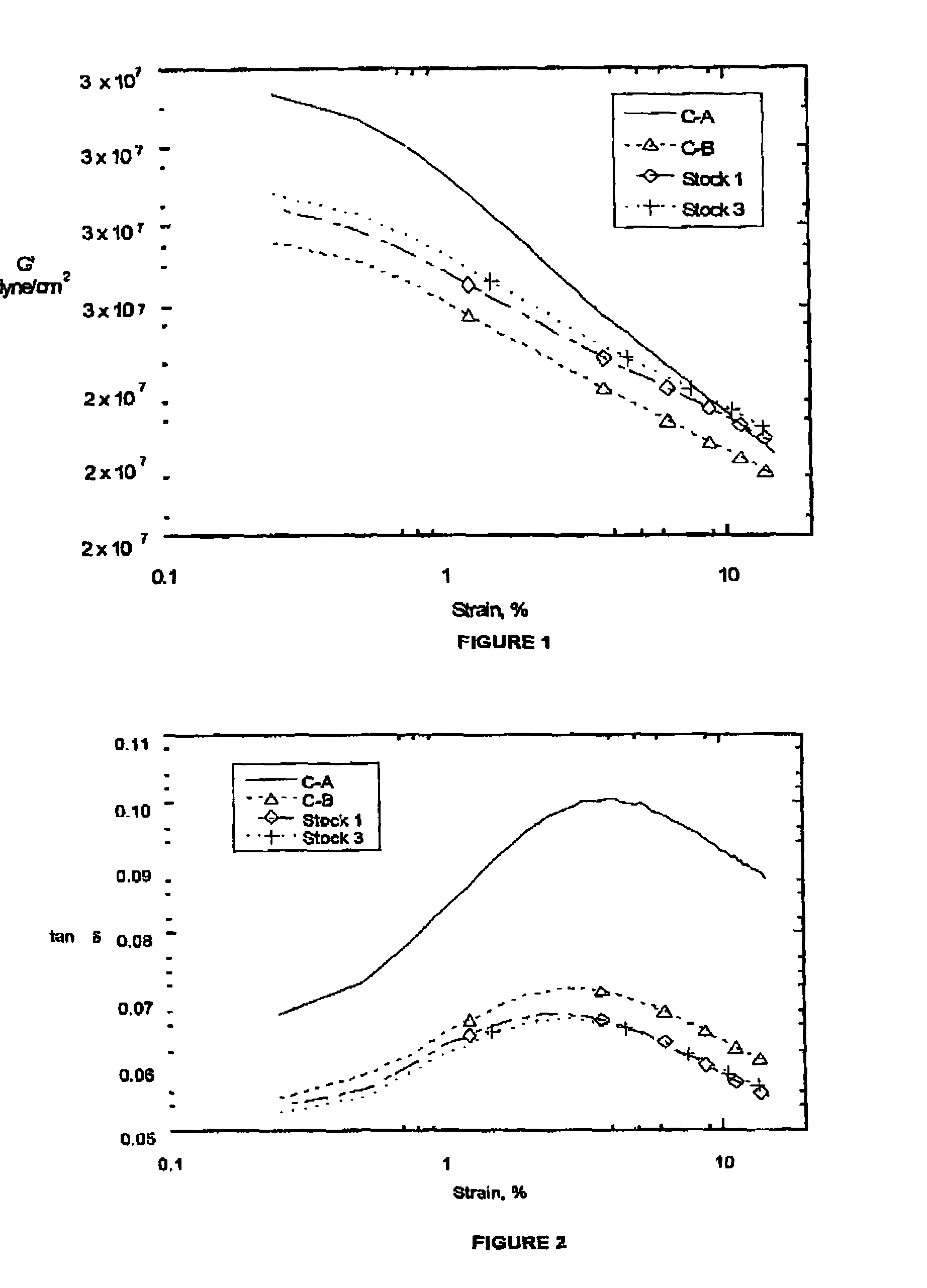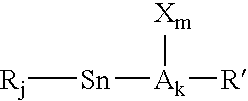Silica-reinforced rubber compounded with an alkoxysilane and a catalytic alkyl tin compound
a technology of alkyl tin and silica, which is applied in the direction of film/foil adhesives, tyre parts, vehicle components, etc., can solve the problems of poor silica dispersion and high compound viscosity, rigid uncured compound that is difficult to process, and disadvantages of bifunctional silica coupling agents, etc., to achieve faster curing rate, reduce ethanol evolution, and prolong scorch time
- Summary
- Abstract
- Description
- Claims
- Application Information
AI Technical Summary
Benefits of technology
Problems solved by technology
Method used
Image
Examples
example 1
Synthesis of Tin-Coupled TEOS-Terminated SBR
[0081]This polymer is a solution styrene-butadiene rubber (SBR) copolymer, in which some of the polymer chains are tin-coupled and others are terminated with an tetraethoxysilane (TEOS) functionalizing agent to produce an ethoxysilane terminated polymer, P—Si—(OEt)3 This polymer was used to prepare the five rubber stocks listed in Tables 1 and 2.
[0082]To a one gallon reactor was charged 0.07 kg of hexane, 0.41 kg of 33.0 percent by weight styrene in hexane, and 1.74 kg 22.4 percent by weight butadiene in hexane. Then, 0.28 ml of 1.6 M 2-2′-di(tetrahydrofuryl)propane in hexane, 0.63 ml of 0.6 M potassium t-amylate in hexane, 1.42 ml of 3.54 M hexamethyleneimine and 3.93 ml of 1.6 M n-butyl lithium in hexane were charged into the reactor, and the jacket temperature was set at 122° F. After 97 minutes, 2.20 ml of 0.25 M tin tetrachloride in hexane was added to the reactor. Ten minutes later, 2.53 ml of 1.12 M tetraethoxyorthosilicate was adde...
example 2
[0083]In order to demonstrate the methods of preparation and properties of the vulcanized elastomeric compounds of the invention, the five stocks employing the tin-coupled TEOS-terminated rubber prepared in Example 1 were compounded using the compounding formulations and mixing conditions shown in Tables 1 and 2. Each of the invention stocks was compounded with silica and the other ingredients, in the master batch stage to a temperature of 175° C., and then cooled and remilled to a temperature of 155° C., prior to adding the curatives and sulfur in the final mixing stage.
[0084]As illustrated in Tables 2 and 3, invention stocks 1, 2 and 3 were rubber stocks compounded with silica, octyl triethoxysilane (OTES), and 3-mercaptopropyltriethoxysilane (MS) at a ratio of MS:OTES of 0.067:1, and an alkyl tin catalyst in the master batch stage to an achieved temperature of 175° C. For comparison, example C-A was the same rubber compounded with silica and the silica coupling agent, Si69, in th...
example 3
[0092]The green stock (i.e., the stock obtained after the final stage, prior to curing) was characterized as to Mooney viscosity and Payne effect (Δ G′) and cure characteristics. The Mooney viscosity measurement was conducted at 130° C. using a large rotor, and was recorded as the torque when rotor had rotated for 4 minutes. The stocks were preheated at 130° C. for 1 minute before the rotor was started. The t5 is the time required for the viscosity to increase by five Mooney units during a Mooney scorch measurement. It is used as an index to predict how fast the compound viscosity will increase during processing (e.g., during extrusion). The Payne effect (ΔG′) was measured using an RPA 2000 viscometer (Alpha Technologies). The strain sweep test (ΔG′) was conducted at 50° C. at 0.1 Hz using strain sweeping from 0.25% to 1000%.
[0093]As illustrated in Table 4, a higher bound rubber content was obtained in comparison stock C-B, containing the mercaptosilane and the OTES, in the absence ...
PUM
| Property | Measurement | Unit |
|---|---|---|
| Temperature | aaaaa | aaaaa |
| Temperature | aaaaa | aaaaa |
| Temperature | aaaaa | aaaaa |
Abstract
Description
Claims
Application Information
 Login to View More
Login to View More - R&D
- Intellectual Property
- Life Sciences
- Materials
- Tech Scout
- Unparalleled Data Quality
- Higher Quality Content
- 60% Fewer Hallucinations
Browse by: Latest US Patents, China's latest patents, Technical Efficacy Thesaurus, Application Domain, Technology Topic, Popular Technical Reports.
© 2025 PatSnap. All rights reserved.Legal|Privacy policy|Modern Slavery Act Transparency Statement|Sitemap|About US| Contact US: help@patsnap.com



